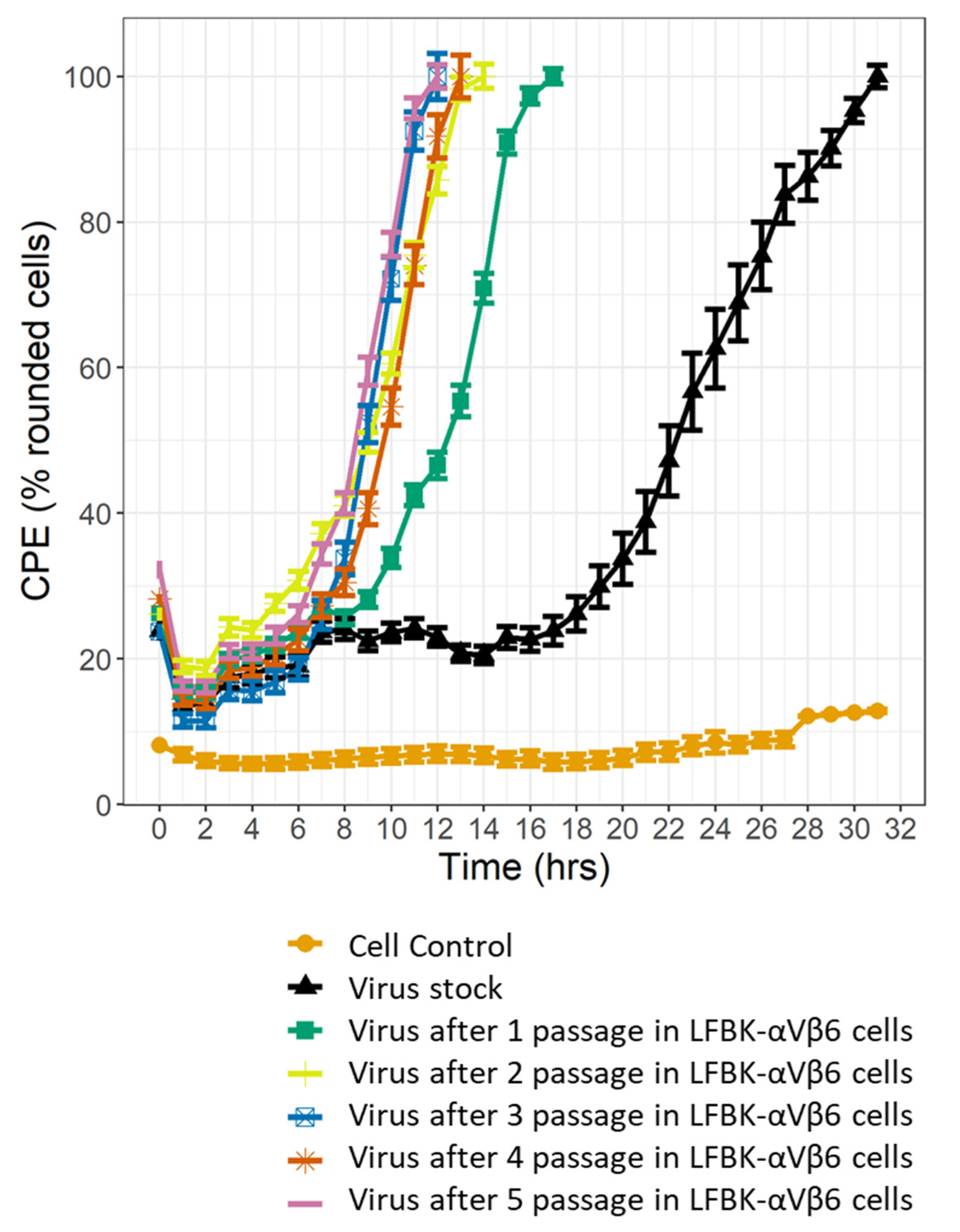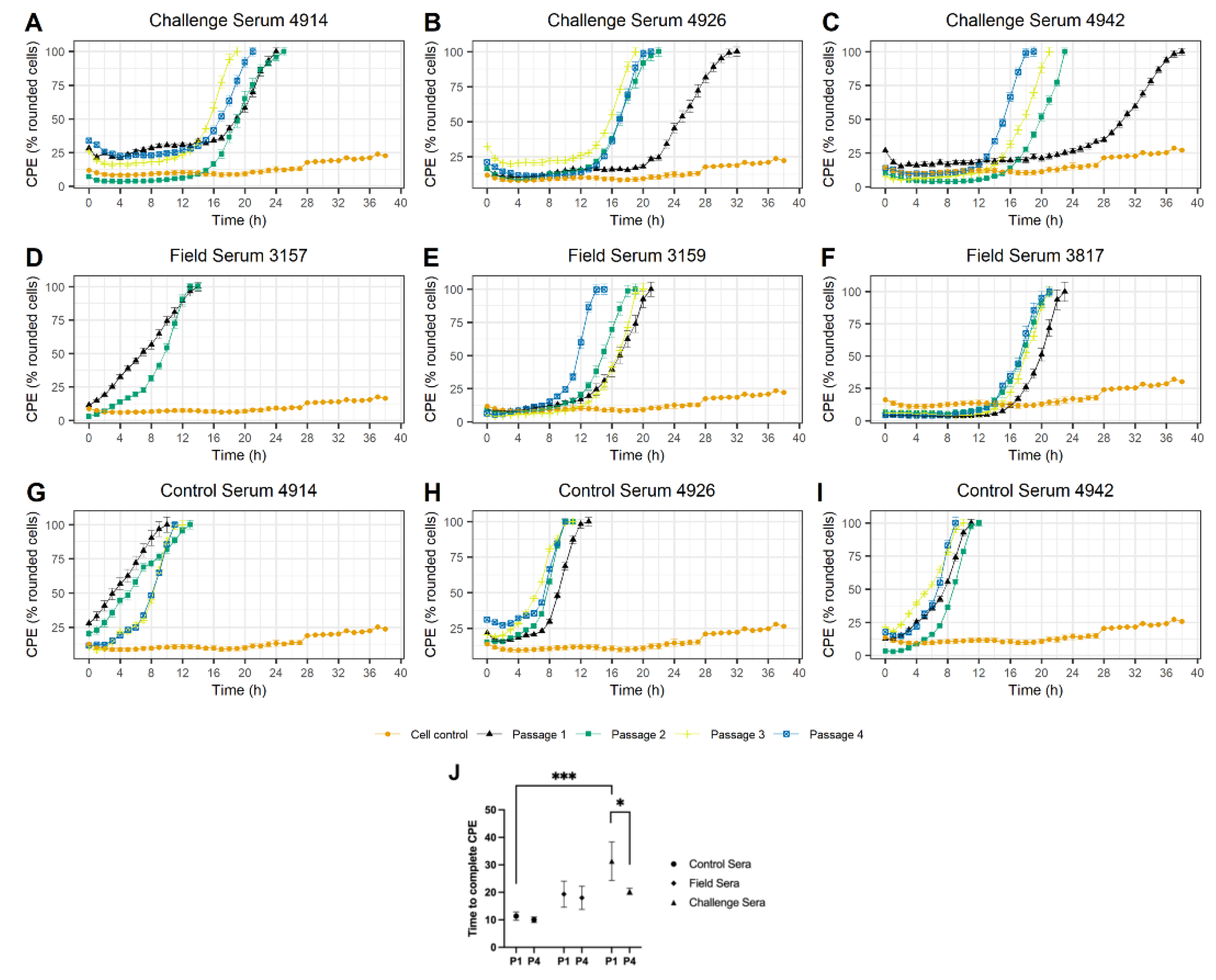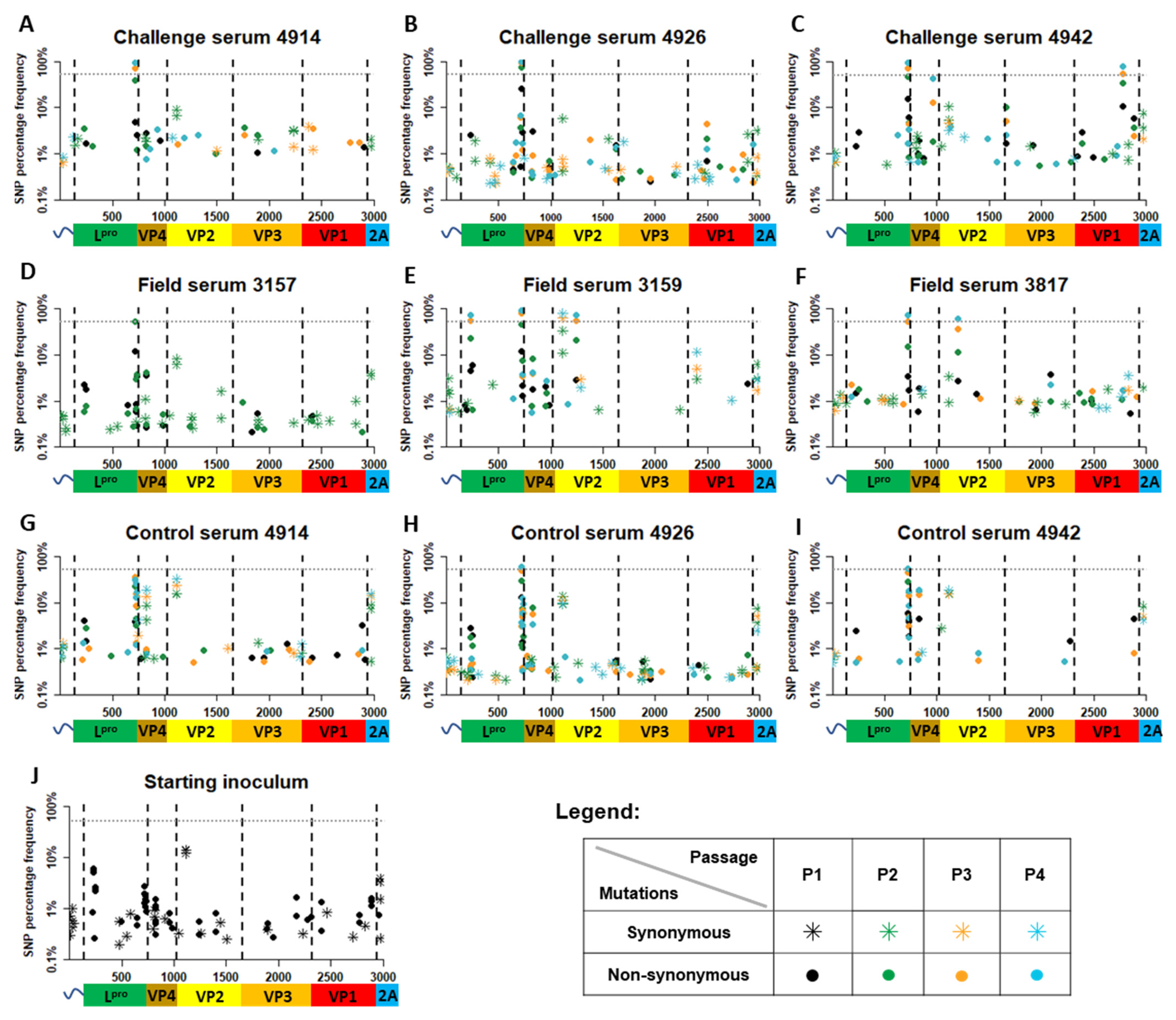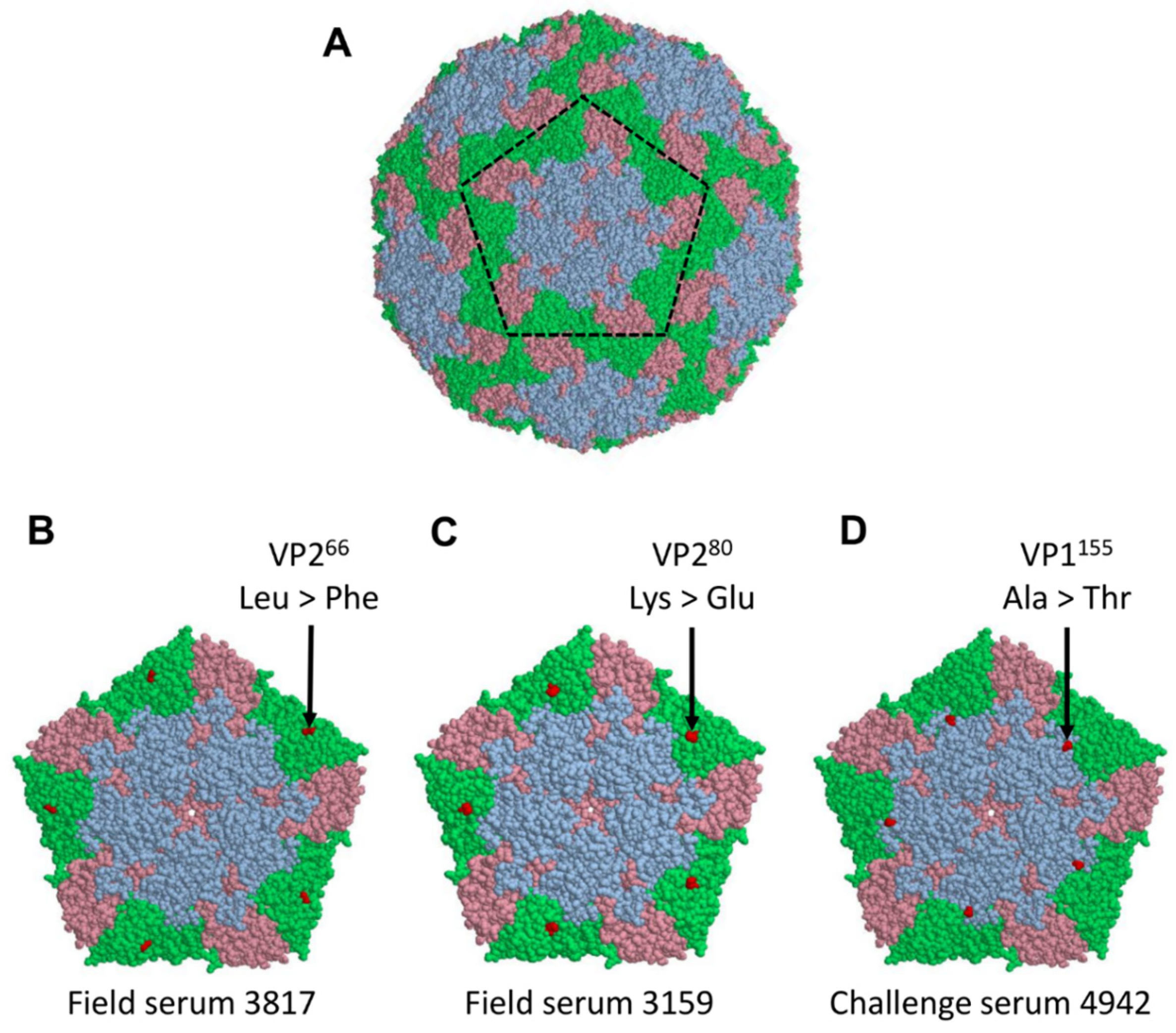Establishing an In Vitro System to Assess How Specific Antibodies Drive the Evolution of Foot-and-Mouth Disease Virus
Abstract
:1. Introduction
2. Materials and Methods
2.1. Cells
2.2. Virus Isolate
2.3. Sera
2.4. Selection of Sub-Neutralising Levels of Antibodies
2.5. Virus Antibody Passage Series
2.6. Sequencing
2.7. Bioinformatics Analysis
2.8. Mapping Mutations onto A Structure of the FMDV Capsid
3. Results
3.1. Viral Adaptation to the LFBK-αVβ6 Cell Line
3.2. Viral Adaptation to Sub-Neutralising Levels of FMDV-Specific Antisera
3.3. Identification of Mutations Acquired during Viral Passage in the Presence of FMDV Sub-Neutralising Sera
3.4. Non-Synonymous Substitutions Exposed on the FMDV Capsid Surface
4. Discussion
Supplementary Materials
Author Contributions
Funding
Institutional Review Board Statement
Informed Consent Statement
Data Availability Statement
Conflicts of Interest
Appendix A. Plaque Assay Methodology
References
- Yoon, H.S.; Park, W.; King, P.D.; Kim, H. Phylogenomics and molecular evolution of foot-and-mouth disease virus. Mol. Cell 2011, 31, 413–421. [Google Scholar] [CrossRef] [PubMed]
- Drake, J.W. Rates of spontaneous mutation among RNA viruses. Proc. Natl. Acad. Sci. USA 1993, 90, 4171–4175. [Google Scholar] [CrossRef] [PubMed]
- Domingo, E.; Holland, J.J. RNA virus mutations and fitness for survival. Annu. Rev. Microbiol. 1997, 51, 151–178. [Google Scholar] [CrossRef] [PubMed]
- Drake, J.W.; Holland, J.J. Mutation rates among RNA viruses. Proc. Natl. Acad. Sci. USA 1999, 96, 13910–13913. [Google Scholar] [CrossRef] [PubMed]
- Haydon, D.T.; Samuel, A.R.; Knowles, N.J. The generation and persistence of genetic variation in foot-and-mouth disease virus. Prev. Vet. Med. 2001, 51, 111–124. [Google Scholar] [CrossRef]
- Keele, B.F.; Anderson, J.A.; Lee, H.Y.; Korber, B.T.M.; Giorgi, E.E.; Blattner, W.A.; Salazar-Gonzalez, J.F.; Goepfert, P.A.; Decker, J.M.; Pham, K.T.; et al. Identification and characterization of transmitted and early founder virus envelopes in primary HIV-1 infection. Proc. Natl. Acad. Sci. USA 2008, 105, 7552–7557. [Google Scholar] [CrossRef]
- King, D.J.; Freimanis, G.L.; Orton, R.J.; Waters, R.A.; Haydon, D.T.; King, D.P. Investigating intra-host and intra-herd sequence diversity of foot-and-mouth disease virus. Infect. Genet. Evol. 2016, 44, 286–292. [Google Scholar] [CrossRef]
- Orton, R.J.; Wright, C.F.; King, D.P.; Haydon, D.T. Estimating viral bottleneck sizes for FMDV transmission within and between hosts and implications for the rate of viral evolution. Interface Focus 2020, 10, 20190066. [Google Scholar] [CrossRef]
- Ahmad, L. Implication of SARS-CoV-2 Immune Escape Spike Variants on Secondary and Vaccine Breakthrough Infections. Front. Immunol. 2021, 12, 742167. [Google Scholar] [CrossRef]
- Hoper, D.; Kalthoff, D.; Hoffmann, B.; Beer, M. Highly Pathogenic Avian Influenza Virus Subtype H5N1 Escaping Neutralization: More than HA Variation. J. Virol. 2012, 86, 1394–1404. [Google Scholar] [CrossRef]
- Wang, R.; Chen, J.; Wei, G.W. Mechanisms of SARS-CoV-2 Evolution Revealing Vaccine-Resistant Mutations in Europe and America. J. Phys. Chem. Lett. 2021, 12, 11850–11857. [Google Scholar] [CrossRef] [PubMed]
- Lazarevic, I.; Banko, A.; Miljanovic, D.; Cupic, M. Immune-Escape Hepatitis B Virus Mutations Associated with Viral Reactivation upon Immunosuppression. Viruses 2019, 11, 778. [Google Scholar] [CrossRef] [PubMed]
- Weisblum, Y.; Schmidt, F.; Zhang, F.; DaSilva, J.; Poston, D.; Lorenzi, J.C.; Muecksch, F.; Rutkowska, M.; Hoffmann, H.H.; Michailidis, E.; et al. Escape from neutralizing antibodies by SARS-CoV-2 spike protein variants. Elife 2020, 9, e61312. [Google Scholar] [CrossRef] [PubMed]
- Liu, Z.; VanBlargan, L.A.; Bloyet, L.M.; Rothlauf, P.W.; Chen, R.E.; Stumpf, S.; Zhao, H.; Errico, J.M.; Theel, E.S.; Liebeskind, M.J.; et al. Identification of SARS-CoV-2 spike mutations that attenuate monoclonal and serum antibody neutralization. Cell Host Microbe 2021, 29, 477–488.e4. [Google Scholar] [CrossRef]
- Locarnini, S.A.; Yuen, L. Molecular genesis of drug-resistant and vaccine-escape HBV mutants. Antivirus Ther. 2010, 15, 451–461. [Google Scholar] [CrossRef]
- Mohapatra, J.K.; Subramaniam, S.; Pandey, L.K.; Pawar, S.S.; De, A.; Das, B.; Sanyal, A.; Pattnaik, B. Phylogenetic structure of serotype a foot-and-mouth disease virus: Global diversity and the Indian perspective. J. Gen. Virol. 2011, 92, 873–879. [Google Scholar] [CrossRef]
- Bachanek-Bankowska, K.; Di Nardo, A.; Wadsworth, J.; Henry, E.K.M.; Parlak, Ü.; Timina, A.; Mischenko, A.; Qasim, I.A.; Abdollahi, D.; Sultana, M.; et al. Foot-and-Mouth Disease in the Middle East Caused by an A/ASIA/G-VII Virus Lineage, 2015–2016. Emerg. Infect. Dis. 2018, 24, 2015–2016. [Google Scholar] [CrossRef]
- Lyons, N.A.; Ludi, A.B.; Wilsden, G.; Hamblin, P.; Qasim, I.A.; Gubbins, S.; King, D.P. Evaluation of a polyvalent foot-and-mouth disease virus vaccine containing A Saudi-95 against field challenge on large-scale dairy farms in Saudi Arabia with the emerging A/ASIA/G-VII viral lineage. Vaccine 2017, 35, 6850–6857. [Google Scholar] [CrossRef]
- Martín, V.; Perales, C.; Dávila, M.; Domingo, E. Viral fitness can influence the repertoire of virus variants selected by antibodies. J. Mol. Biol. 2006, 362, 44–54. [Google Scholar] [CrossRef]
- Sarangi, L.N.; Mohapatra, J.K.; Subramaniam, S.; Sanyal, A.; Pattnaik, B. Antigenic site variation in foot-and-mouth disease virus serotype O grown under vaccinal serum antibodies in vitro. Virus Res. 2013, 176, 273–279. [Google Scholar] [CrossRef]
- King, D.J.; Freimanis, G.; Lasecka-Dykes, L.; Asfor, A.; Ribeca, P.; Waters, R.; King, D.P.; Laing, E. A Systematic Evaluation of High-Throughput Sequencing Approaches to Identify Low-Frequency Single Nucleotide Variants in Viral Populations. Viruses 2020, 12, 1187. [Google Scholar] [CrossRef]
- LaRocco, M.; Krug, P.W.; Kramer, E.; Ahmed, Z.; Pacheco, J.M.; Duque, H.; Baxt, B.; Rodriguez, L.L. A continuous bovine kidney cell line constitutively expressing bovine αVβ6 integrin has increased susceptibility to foot-and-mouth disease virus. J. Clin. Microbiol. 2013, 51, 1714–1720. [Google Scholar] [CrossRef]
- Duque, H.; LaRocco, M.; Golde, W.T.; Baxt, B. Interactions of foot-and-mouth disease virus with soluble bovine alphaVbeta3 and alphaVbeta6 integrins. J. Virol. 2004, 78, 9773–9781. [Google Scholar] [CrossRef]
- Garcia-Arriaza, J.; Manrubia, S.C.; Toja, M.; Domingo, E.; Escarmis, C. Evolutionary transition toward defective RNAs that are infectious by complementation. J. Virol. 2004, 78, 11678–11685. [Google Scholar] [CrossRef] [PubMed]
- Waters, R.; Ludi, A.B.; Fowler, V.L.; Wilsden, G.; Browning, C.; Gubbins, S.; Statham, B.; Bin-Tarif, A.; Mioulet, V.; King, D.J.; et al. Efficacy of a high-potency multivalent foot-and-mouth disease virus vaccine in cattle against heterologous challenge with a field virus from the emerging A/ASIA/G-VII lineage. Vaccine 2018, 36, 1901–1907. [Google Scholar] [CrossRef] [PubMed]
- Callahan, J.D.; Brown, F.; Osorio, F.A.; Sur, J.H.; Kramer, E.; Long, G.W.; Lubroth, J.; Ellis, S.J.; Shoulars, K.S.; Gaffney, K.L.; et al. Use of a portable real-time reverse transcriptase-polymerase chain reaction assay for rapid detection of foot-and-mouth disease virus. J. Am. Vet. Med. Assoc. 2002, 220, 1636–1642. [Google Scholar] [CrossRef]
- Cottam, E.M.; Haydon, D.T.; Paton, D.J.; Gloster, J.; Wilesmith, J.W.; Ferris, N.P.; Hutchings, G.H.; King, D.P. Molecular epidemiology of the foot-and-mouth disease virus outbreak in the United Kingdom in 2001. J. Virol. 2006, 80, 11274–11282. [Google Scholar] [CrossRef] [PubMed]
- Xu, L.; Hurtle, W.; Rowland, J.M.; Casteran, K.A.; Bucko, S.M.; Grau, F.R.; Valdazo-Gonzalez, B.; Knowles, N.J.; King, D.P.; Beckham, T.R.; et al. Development of a universal RT-PCR for amplifying and sequencing the leader and capsid-coding region of foot-and-mouth disease virus. J. Virol. Methods 2013, 189, 70–76. [Google Scholar] [CrossRef]
- Andrews, S. FastQC: A Quality Control Tool for High Throughput Sequence Data (Version 0.11.5) [Software]. 2010. Available online: http://www.bioinformatics.babraham.ac.uk/projects/fastqc/ (accessed on 18 August 2021).
- Schmieder, R.; Edwards, R. Quality control and preprocessing of metagenomic datasets. Bioinformatics 2011, 27, 863–864. [Google Scholar] [CrossRef] [PubMed]
- Joshi, N.; Fass, J. Sickle: A Sliding-Window, Adaptive, Quality-Based Trimming Tool for FastQ Files (Version 1.33) [Software]. Available online: https://github.com/najoshi/sickle (accessed on 18 August 2021).
- Peng, Y.; Leung, H.C.M.; Yiu, S.M.; Chin, F.Y.L. IDBA-UD: A de novo assembler for single-cell and metagenomic sequencing data with highly uneven depth. Bioinformatics 2012, 28, 1420–1428. [Google Scholar] [CrossRef]
- Altschul, S.F.; Gish, W.; Miller, W.; Myers, E.W.; Lipman, D.J. Basic local alignment search tool. J. Mol. Biol. 1990, 215, 403–410. [Google Scholar] [CrossRef]
- Marco-Sola, S.; Sammeth, M.; Guigo, R.; Ribeca, P. The GEM mapper: Fast, accurate and versatile alignment by filtration. Nat. Methods 2012, 9, 1185–1188. [Google Scholar] [CrossRef] [PubMed]
- Li, H.; Handsaker, B.; Wysoker, A.; Fennell, T.; Ruan, J.; Homer, N.; Marth, G.; Abecasis, G.; Durbin, R.; 1000 Genome Project Data Processing Subgroup. The Sequence Alignment/Map format and SAMtools. Bioinformatics 2009, 25, 2078–2079. [Google Scholar] [CrossRef] [PubMed]
- Quinlan, A.R. BEDTools: The Swiss-Army Tool for Genome Feature Analysis. Curr. Protoc. Bioinform. 2014, 47, 11–12. [Google Scholar] [CrossRef] [PubMed]
- Kotecha, A.; Seago, J.; Scott, K.; Burman, A.; Loureiro, S.; Ren, J.; Porta, C.; Ginn, H.M.; Jackson, T.; Perez-martin, E.; et al. Structure-based energetics of protein interfaces guide Foot-and- Mouth Disease virus vaccine design. Nat. Struct. Mol. Biol. 2015, 22, 788–794. [Google Scholar] [CrossRef] [PubMed]
- Sayle, R.A.; Milner-White, E.J. RASMOL: Biomolecular graphics for all. Trends Biochem. Sci. 1995, 20, 374–376. [Google Scholar] [CrossRef]
- Bernstein, H.J. Recent changes to RasMol, recombining the variants. Trends Biochem. Sci. 2000, 25, 453–455. [Google Scholar] [CrossRef]
- Medina, G.N.; Segundo, F.D.; Stenfeldt, C.; Arzt, J.; de Los Santos, T. The Different Tactics of Foot-and-Mouth Disease Virus to Evade Innate Immunity. Front. Microbiol. 2018, 9, 2644. [Google Scholar] [CrossRef]
- Chinsangaram, J.; Koster, M.; Grubman, M.J. Inhibition of L-deleted foot-and-mouth disease virus replication by alpha/beta interferon involves double-stranded RNA-dependent protein kinase. J. Virol. 2001, 75, 5498–5503. [Google Scholar] [CrossRef]
- Moraes, M.P.; de Los Santos, T.; Koster, M.; Turecek, T.; Wang, H.; Andreyev, V.G.; Grubman, M.J. Enhanced antiviral activity against foot-and-mouth disease virus by a combination of type I and II porcine interferons. J. Virol. 2007, 81, 7124–7135. [Google Scholar] [CrossRef]
- Ludi, A.B.; Horton, D.L.; Li, Y.; Mahapatra, M.; King, D.P.; Knowles, N.J.; Russell, C.A.; Paton, D.J.; Wood, J.L.N.; Smith, D.J.; et al. Antigenic variation of foot-and-mouth disease virus serotype A. J. Gen. Virol. 2014, 95, 384–392. [Google Scholar] [CrossRef] [PubMed]
- Thomas, A.A.; Woortmeijer, R.J.; Puijk, W.; Barteling, S.J. Antigenic sites on foot-and-mouth disease virus type A10. J. Virol. 1988, 62, 2782–2789. [Google Scholar] [CrossRef] [PubMed]
- Bari, F.D.; Parida, S.; Asfor, A.S.; Haydon, D.T.; Reeve, R.; Paton, D.J.; Mahapatra, M. Prediction and characterization of novel epitopes of serotype A foot-and-mouth disease viruses circulating in East Africa using site-directed mutagenesis. J. Gen. Virol. 2015, 96, 1033–1041. [Google Scholar] [CrossRef] [PubMed]
- Saiz, J.C.; Gonzalez, M.J.; Borca, M.V.; Sobrino, F.; Moore, D.M. Identification of neutralizing antigenic sites on VP1 and VP2 of type A5 foot-and-mouth disease virus, defined by neutralization-resistant variants. J. Virol. 1991, 65, 2518–2524. [Google Scholar] [CrossRef] [PubMed]
- Bolwell, C.; Clarke, B.E.; Parry, N.R.; Ouldridge, E.J.; Brown, F.; Rowlands, D.J. Epitope mapping of foot-and-mouth disease virus with neutralizing monoclonal antibodies. J. Gen. Virol. 1989, 70, 59–68. [Google Scholar] [CrossRef]
- Katpally, U.; Fu, T.M.; Freed, D.C.; Casimiro, D.R.; Smith, T.J. Antibodies to the buried N terminus of rhinovirus VP4 exhibit cross-serotypic neutralization. J. Virol. 2009, 83, 7040–7048. [Google Scholar] [CrossRef]
- Lewis, J.K.; Bothner, B.; Smith, T.J.; Siuzdak, G. Antiviral agent blocks breathing of the common cold virus. Proc. Natl. Acad. Sci. USA 1998, 95, 6774–6778. [Google Scholar] [CrossRef]
- Li, Q.; Yafal, A.G.; Lee, Y.M.; Hogle, J.; Chow, M. Poliovirus neutralization by antibodies to internal epitopes of VP4 and VP1 results from reversible exposure of these sequences at physiological temperature. J. Virol. 1994, 68, 3965–3970. [Google Scholar] [CrossRef]
- Liu, Y.; Zhu, Z.; Zhang, M.; Zheng, H. Multifunctional roles of leader protein of foot-and-mouth disease viruses in suppressing host antiviral responses. Vet. Res. 2015, 46, 127. [Google Scholar] [CrossRef]
- Rodriguez Pulido, M.; Sanchez-Aparicio, M.T.; Martinez-Salas, E.; Garcia-Sastre, A.; Sobrino, F.; Saiz, M. Innate immune sensor LGP2 is cleaved by the Leader protease of foot-and-mouth disease virus. PLoS Pathog. 2018, 14, e1007135. [Google Scholar] [CrossRef]
- Guarne, A.; Tormo, J.; Kirchweger, R.; Pfistermueller, D.; Fita, I.; Skern, T. Structure of the foot-and-mouth disease virus leader protease: A papain-like fold adapted for self-processing and eIF4G recognition. EMBO J. 1998, 17, 7469–7479. [Google Scholar] [CrossRef] [PubMed]




| Passage | |||||||
|---|---|---|---|---|---|---|---|
| Protein | Amino Acid Substitution | Serum Sample | + Starting Inoculum | 1 | 2 | 3 | 4 |
| Lpro | K29R | Control 4914 | 5.63% | 4.10% | ND | ND | ND |
| Control 4926 | 2.75% | 1.72% | 0.42% | 0.34% | |||
| Control 4942 | 2.47% | ND | ND | 0.50% | |||
| Field 3157 | 2.23% | 0.60% | |||||
| Field 3159 | 4.45% | 22.94% | 55.98% | 74.39% | |||
| Field 3817 | 1.46% | ND | ND | ND | |||
| Challenge 4914 | 3.52% | 3.43% | ND | ND | |||
| Challenge 4926 | 2.53% | ND | ND | ND | |||
| Challenge 4942 | 1.42% | ND | ND | ND | |||
| N189D | Challenge 4926 | ND | 0.53% | 3.64% | 5.92% | 6.73% | |
| W192R | Control 4914 | 1.96% | 3.81% | 22.40% | 35.12% | 31.14% | |
| Control 4926 | 12.74% | 29.63% | 49.74% | 58.65% | |||
| Control 4942 | 5.84% | 28.46% | 44.14% | 53.30% | |||
| Field 3157 | 12.18% | 52.28% | |||||
| Field 3159 | 12.06% | 46.39% | 80.50% | 93.84% | |||
| Field 3817 | 3.50% | 15.31% | 52.20% | 71.21% | |||
| Challenge 4914 | 4.87% | 38.63% | 71.33% | 93.92% | |||
| Challenge 4926 | 25.36% | 73.50% | 91.96% | 97.07% | |||
| Challenge 4942 | 15.57% | 47.17% | 69.96% | 91.74% | |||
| VP4 | L71P | Field 3159 | ND | ND | 1.50% | ND | 2.74% |
| Challenge 4926 | ND | ND | 0.49% | 0.28% | |||
| Challenge 4942 | ND | 1.83% | 12.64% | 42.07% | |||
| VP2 | S37 | Control 4914 | 13.17% | 15.58% | 15.76% | 23.68% | 32.35% |
| Control 4926 | 9.23% | 13.61% | 11.30% | 9.59% | |||
| Control 4942 | 15.39% | 18.62% | 15.65% | 18.41% | |||
| Field 3157 | 8.08% | 6.13% | |||||
| Field 3159 | 10.93% | 33.43% | 62.52% | 78.53% | |||
| Field 3817 | 3.37% | 0.93% | ND | ND | |||
| Challenge 4914 | 8.90% | 6.53% | ND | ND | |||
| Challenge 4926 | 5.68% | 0.41% | 0.75% | ND | |||
| Challenge 4942 | 10.38% | 5.28% | 4.58% | 3.11% | |||
| L66F | Field 3817 | ND | 2.76% | 11.35% | 35.70% | 60.95% | |
| K80E | Field 3157 | 0.44% | ND | 0.28% | |||
| Field 3159 | 2.84% | 21.08% | 54.08% | 71.96% | |||
| VP3 | P4S | Challenge 4942 | ND | 1.69% | 9.89% | 5.07% | 2.48% |
| VP1 | Q58H | Challenge 4926 | ND | 0.68% | 2.11% | 4.33% | 1.28% |
| A155T | Field 3817 | ND | ND | ND | ND | 1.68% | |
| Challenge 4942 | 10.49% | 34.44% | 52.37% | 76.38% | |||
Publisher’s Note: MDPI stays neutral with regard to jurisdictional claims in published maps and institutional affiliations. |
© 2022 by the authors. Licensee MDPI, Basel, Switzerland. This article is an open access article distributed under the terms and conditions of the Creative Commons Attribution (CC BY) license (https://creativecommons.org/licenses/by/4.0/).
Share and Cite
King, D.J.; Freimanis, G.; Neil, C.; Shaw, A.; Tuthill, T.J.; Laing, E.; King, D.P.; Lasecka-Dykes, L. Establishing an In Vitro System to Assess How Specific Antibodies Drive the Evolution of Foot-and-Mouth Disease Virus. Viruses 2022, 14, 1820. https://doi.org/10.3390/v14081820
King DJ, Freimanis G, Neil C, Shaw A, Tuthill TJ, Laing E, King DP, Lasecka-Dykes L. Establishing an In Vitro System to Assess How Specific Antibodies Drive the Evolution of Foot-and-Mouth Disease Virus. Viruses. 2022; 14(8):1820. https://doi.org/10.3390/v14081820
Chicago/Turabian StyleKing, David J., Graham Freimanis, Chris Neil, Andrew Shaw, Tobias J. Tuthill, Emma Laing, Donald P. King, and Lidia Lasecka-Dykes. 2022. "Establishing an In Vitro System to Assess How Specific Antibodies Drive the Evolution of Foot-and-Mouth Disease Virus" Viruses 14, no. 8: 1820. https://doi.org/10.3390/v14081820
APA StyleKing, D. J., Freimanis, G., Neil, C., Shaw, A., Tuthill, T. J., Laing, E., King, D. P., & Lasecka-Dykes, L. (2022). Establishing an In Vitro System to Assess How Specific Antibodies Drive the Evolution of Foot-and-Mouth Disease Virus. Viruses, 14(8), 1820. https://doi.org/10.3390/v14081820







